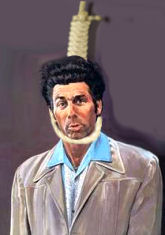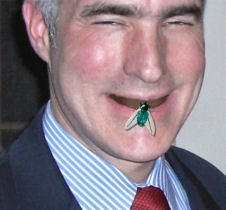Kramer's Self-Lynching
 Tuesday, November 21, 2006 at 04:23PM
Tuesday, November 21, 2006 at 04:23PM  Quote: “At last I feel vindicated for finding him to be the least funny character on that show. After Jerry, that is.” Comment on The Defamer.
Quote: “At last I feel vindicated for finding him to be the least funny character on that show. After Jerry, that is.” Comment on The Defamer.
Figure of Speech: anesis (an-EE-sis), the lessening figure. From the Greek, meaning “abating.”
When the bad-haired, unfunny Michael Richards played Kramer on Seinfeld, we thought he was channeling Phyllis Diller. Turns out he’s really a serious Borat. “Shut up!” he replied wittily to African-American hecklers during his “comedy” routine, adding a nostalgic description of a lynching and liberal use of the N-word.
A Defamer participant named Trixie from Toronto responds with an anesis, one of the subtlest, most enjoyable figures. The anesis begins with a thought and promptly unravels it with a devastating follow-up. Trixie’s anesis kills two celeb birds with one stone: Kramer was the least funny character on Seinfeld. After Jerry.
Cue the rimshot.
Snappy Answer: He’s taking a sensitivity workshop. From Mel Gibson.






